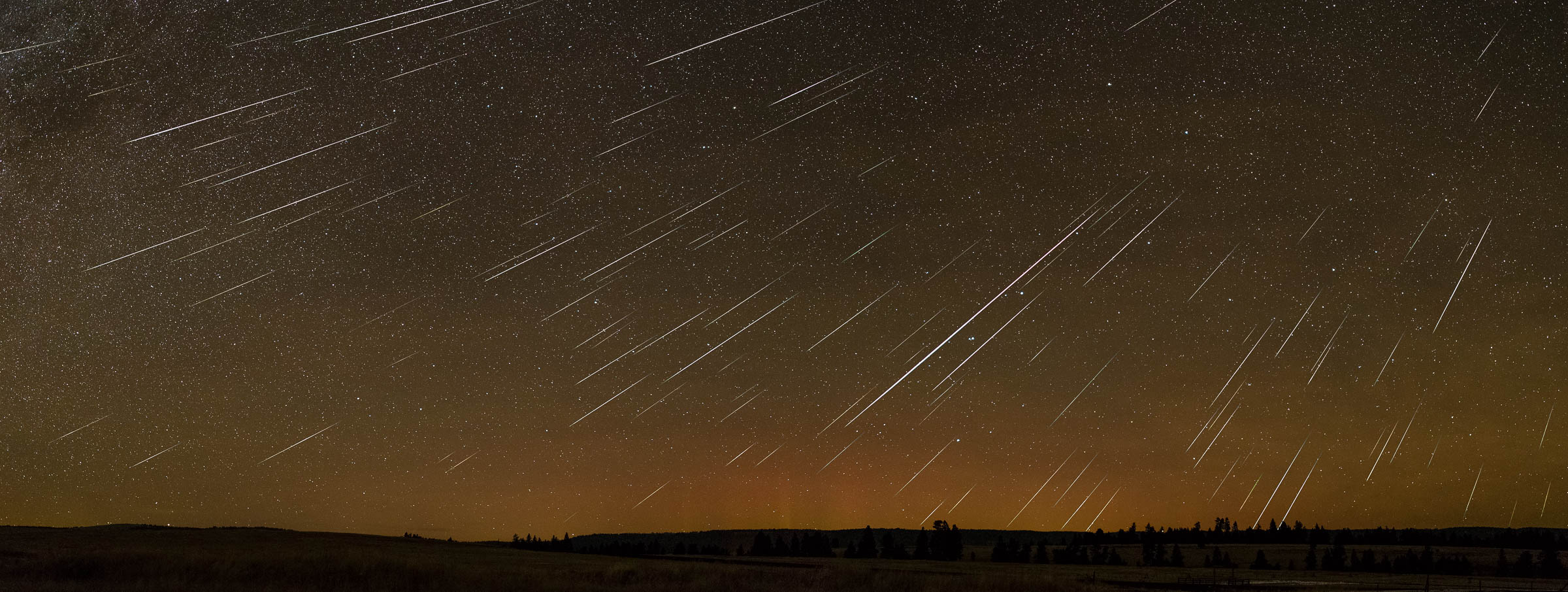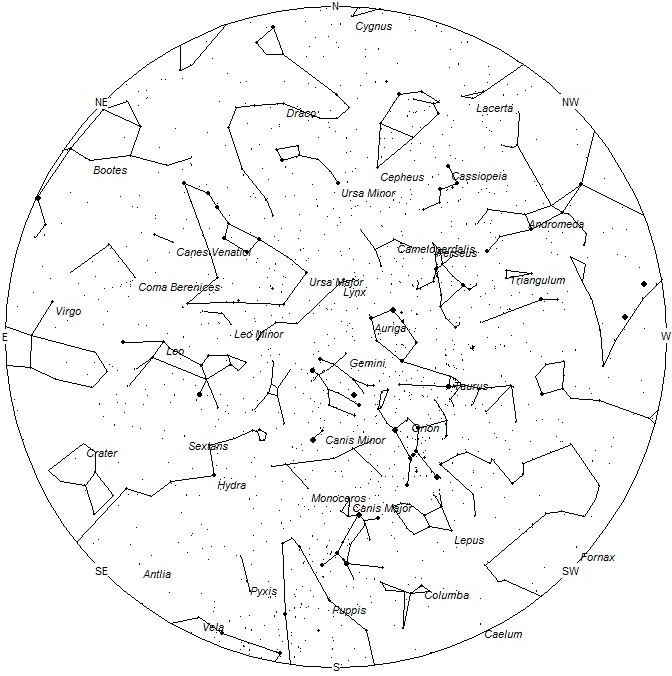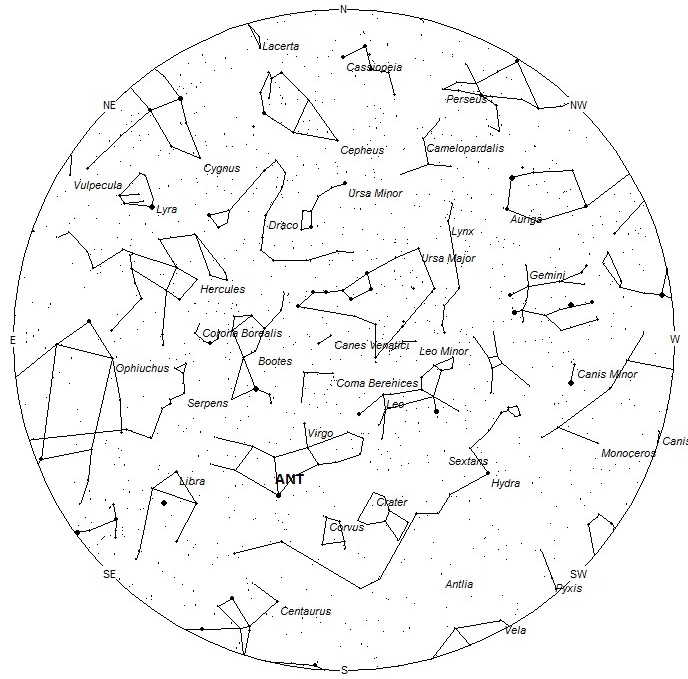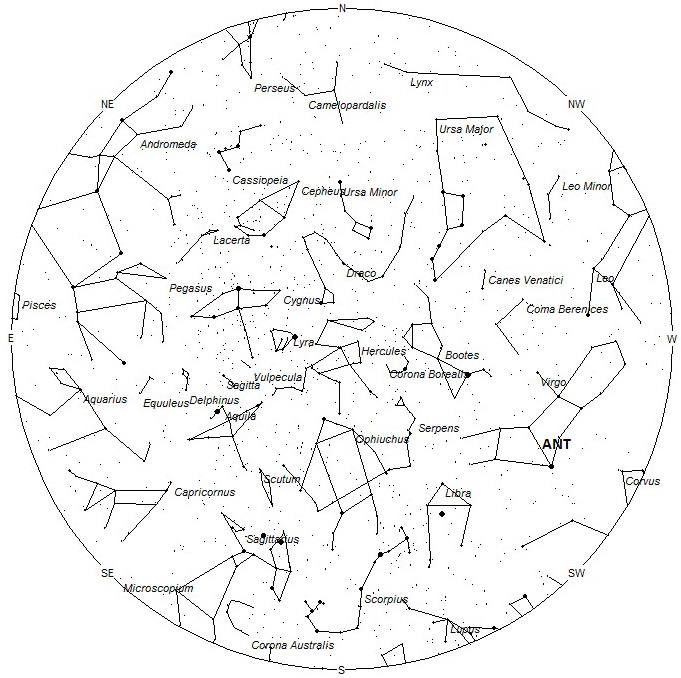
During this period the moon will reach it’s first quarter phase on Saturday March 24. At that time it will be located 90 degrees east of the sun and will set near 02:00 local daylight saving time. (LDT). As the week progresses the waxing gibbous moon will remain in the sky most of the night and will hamper meteor viewing while still visible. The estimated total hourly meteor rates for evening observers this week is 3 as seen from mid-northern latitude (45N) and 4 from the southern tropics (25S). For morning observers the estimated total hourly rates should be near 7 as seen from mid-northern latitudes (45N) and 10 from the southern tropics (25S). The actual rates will also depend on factors such as personal light and motion perception, local weather conditions, alertness and experience in watching meteor activity. Evening rates are reduced during this period due to interfering moonlight. Note that the hourly rates listed below are estimates as viewed from dark sky sites away from urban light sources. Observers viewing from urban areas will see less activity as only the brighter meteors will be visible from such locations.
The radiant (the area of the sky where meteors appear to shoot from) positions and rates listed below are exact for Saturday night/Sunday morning March 24/25. These positions do not change greatly day to day so the listed coordinates may be used during this entire period. Most star atlases (available at science stores and planetariums) will provide maps with grid lines of the celestial coordinates so that you may find out exactly where these positions are located in the sky. A planisphere or computer planetarium program is also useful in showing the sky at any time of night on any date of the year. Activity from each radiant is best seen when it is positioned highest in the sky, either due north or south along the meridian, depending on your latitude. It must be remembered that meteor activity is rarely seen at the radiant position. Rather they shoot outwards from the radiant so it is best to center your field of view so that the radiant lies near the edge and not the center. Viewing there will allow you to easily trace the path of each meteor back to the radiant (if it is a shower member) or in another direction if it is a sporadic. Meteor activity is not seen from radiants that are located far below the horizon. The positions below are listed in a west to east manner in order of right ascension (celestial longitude). The positions listed first are located further west therefore are accessible earlier in the night while those listed further down the list rise later in the night.
These sources of meteoric activity are expected to be active this week.
.
The center of the large Anthelion (ANT) radiant is currently located at 13:08 (197) -07. This position lies in central Virgo, 7 degrees northwest of the 1st magnitude star known as Spica (alpha Virginis). Due to the large size of this radiant, Anthelion activity may also appear from Corvus as well as Virgo. This radiant is best placed near 0200 LDT, when it lies on the meridian and is located highest in the sky. Rates at this time should be near 2 per hour no matter your location. With an entry velocity of 30 km/sec., the average Anthelion meteor would be of slow velocity.
The Gamma Normids (GNO) should be active from the 23rd through the 28th with maximum activity occurring near the 24th. The expected radiant at maximum lies near the position 15:56 (239) -51. This position is located in central Norma, 4 degrees west of the 4th magnitude star known as Gamma 2 Normae. These activity dates and position are different than what you will see printed in other lists as it is based on video data from Australia. Recent observations during the old activity period has revealed little activity from this source so I am confident that these new parameters are closer to reality. This radiant is best placed near 0500 LDT when it lies highest above the horizon. Rates at maximum should be less than 1 per hour as seen from the northern hemisphere and perhaps near 1 as seen from the southern hemisphere. With an entry velocity of 68 km/sec., the average meteor from this source would be of swift velocity.
As seen from the mid-northern hemisphere (45N) one would expect to see approximately 5 sporadic meteors per hour during the last hour before dawn as seen from rural observing sites. Evening rates would be near 2 per hour. As seen from the tropical southern latitudes (25S), morning rates would be near 8 per hour as seen from rural observing sites and 3 per hour during the evening hours. Locations between these two extremes would see activity between the listed figures.
| SHOWER | DATE OF MAXIMUM ACTIVITY | CELESTIAL POSITION | ENTRY VELOCITY | CULMINATION | HOURLY RATE | CLASS |
| RA (RA in Deg.) DEC | Km/Sec | Local Daylight Saving Time | North-South | |||
| Anthelion (ANT) | – | 11:16 (169) -04 | 30 | 02:00 | 2 – 2 | II |
| Gamma Normids (GNO) | Mar 24 | 15:56 (239) -51 | 68 | 06:00 | <1 – 1 | IV |
 American Meteor Society
American Meteor Society



This morning at 7:30am (3/28/18) I watched a big bright green fireball falling across the sky in Douglasville Ga. I have been searching all day to see if anyone else witnessed this super cool sight with no luck. I came across your post and found the explanation. Thank you! I just wish some how it was filmed and I could see it again to show my family.
March 30th 2018 11:33 PM Central Time, I saw a large meteor, (or space junk). Travel was from south to north, and traversed 3/4 for the western sky.
My location is Wisconsin. One thing that amazed me, there was no breakup, considering the sized which would rank as just below the meteor that fell in Livingston WI on Apr 15, 2010, I would have thought there would have been some visible breakup.